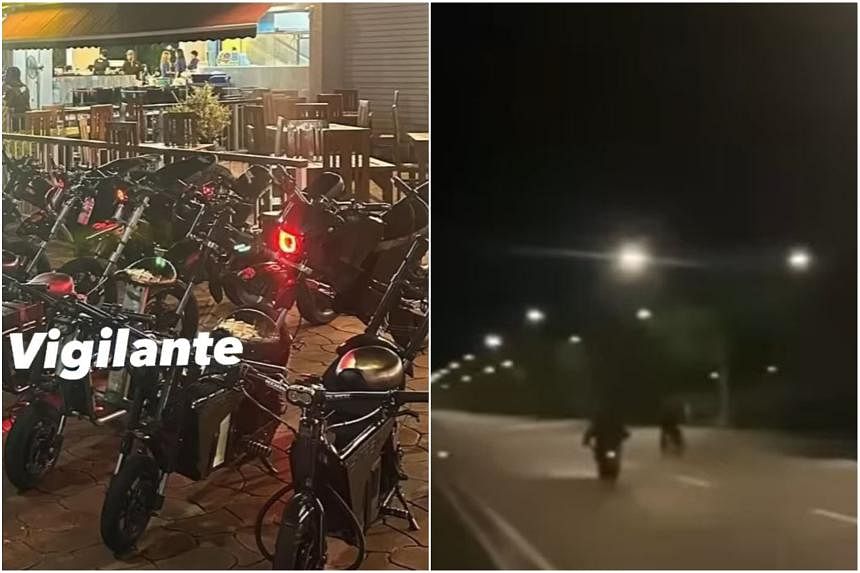Affordable, convenient: Why more people in S’pore are relying on mobility scooters
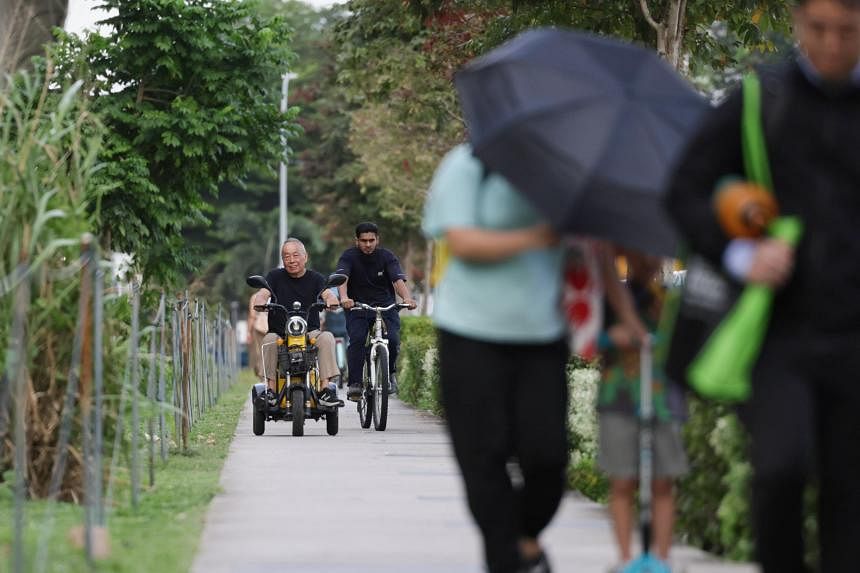
Mobility aids can be used on footpaths and cycling tracks but not on roads. ST PHOTO: GIN TAY
Esther Loi, Leow Wen Xuan and Whitney William
MAR 03, 2024
SINGAPORE – In January 2023, bar musician Mohammed Farhan bought a personal mobility aid (PMA) so that his family can get around more conveniently.
Every weekday, the 36-year-old ferries his daughter, seven, and nephew, 12, to and from Yishun Primary School on his vehicle, which cost him $1,700. The 1km ride each way takes 10 minutes.
Compared with paying $600 monthly for his daughter and nephew – who stays with him on weekdays – to ride the school bus, the family’s sole breadwinner said using the vehicle is considerably cheaper.
Twice-yearly brake maintenance sets him back around $30, and tyre changes every 1½ years cost about $90.
While the authorities define mobility scooters as having just one seat, checks by The Straits Times showed many with more than one seat – like Mr Farhan’s vehicle, which can seat three – are sold online as PMAs.
While he has no trouble walking, Mr Farhan said he prefers commuting on the vehicle because it allows him to take the children to school quickly.
Mr Farhan gets off work only at 5am most days, and relies on his vehicle to take the children to school at about 7am before returning home quickly to get enough rest for his night shift.
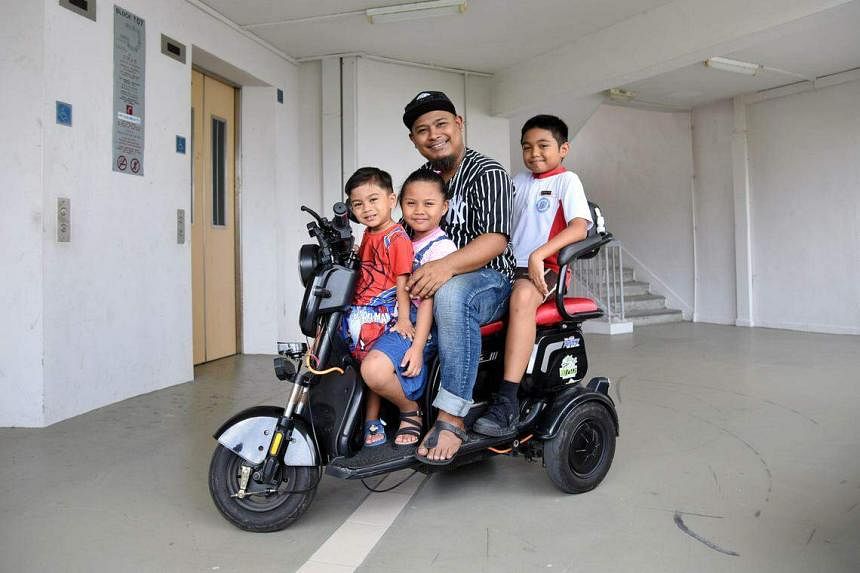
Mr Mohammed Farhan, 36, often ferries (from left) his children Putera Aqeed Shah, four, and Puteri Farzana Aliya, seven, and nephew Ezrul Hanafie, 12, on his three-seater mobility scooter. ST PHOTO: HENG YI-HSIN
PMAs include vehicles such as mobility scooters and motorised wheelchairs, and are meant for people with walking difficulties.
The Ministry of Transport is reviewing recommendations proposed by the Active Mobility Advisory Panel (Amap) in December 2023, including reducing the speed limit of motorised PMAs from 10kmh to 6kmh, and setting in motion a requirement that only people certified with walking difficulties or medical needs can use mobility scooters.
The panel also proposed applying the same dimension restrictions for PMAs on public transport – 70cm wide, 120cm long, 150cm high, and combined weight of 300kg with the rider on board – to those on public paths. For now, there are no dimension restrictions for PMAs on public paths.
Mobility aids can be used on footpaths and cycling tracks, but not on roads.
These recommendations came after the panel flagged rising concerns about able-bodied people misusing PMAs, drawing complaints about dangerous riding, speeding and overly large PMAs.
In 2019, some PMA users made the news after their vehicles crashed into glass doors at Toa Payoh Bus Interchange and the Singapore General Hospital (SGH).
Adjunct Assistant Professor Raj Menon, a senior consultant in the division of general surgery (trauma) at the National University Hospital (NUH), said that since 2020, trauma units across the National University Health System – comprising NUH, Ng Teng Fong General Hospital and Alexandra Hospital – have treated an average of 15 patients involved in PMA accidents yearly.
ST interviewed three other parents who ferry their children using PMAs.
One of them is kitchen assistant Ong Li Li, 42, who takes her 11-year-old son to school on her mobility scooter, and rides it to her workplace at the nearby Northpoint City mall, which is about 15 minutes away.
If they travelled by bus, they would spend more time and money commuting, said Ms Ong.
Earning a living
Food delivery riders with mobility issues who spoke to ST were concerned that the proposed lower speed limit could affect their livelihoods.Mr Noraizam Abdul Rahman, 42, said many PMA users have medical conditions. The GrabFood rider suffered a mild stroke two years ago while delivering an order on a power-assisted bicycle, and his doctor advised him to switch to a mobility scooter.
“Because of these black sheep (who are able-bodied and drive recklessly), we may get penalised,” said Mr Noraizam.
The father of five is worried that the proposed speed limit would cut the number of orders he can complete daily, and, in turn, his income.
GrabFood rider Ramdan Ali, 45, has depended on a mobility scooter to deliver food since he had a slipped disc two years ago.
He said some people can walk faster than the proposed limit of 6kmh.
He said that if the lower speed limit is rolled out, it would take more than an hour – including food preparation time – for him to reach a customer 3km away, compared with 30 to 40 minutes now.
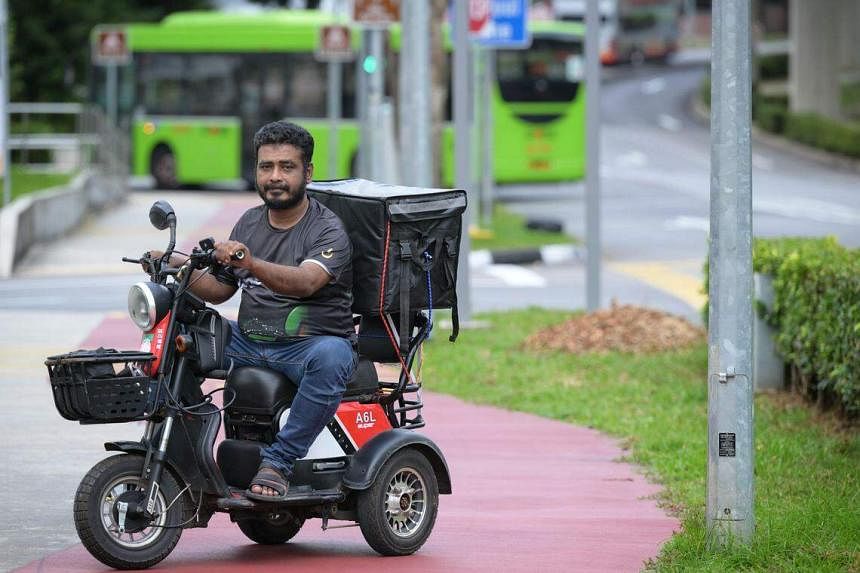
Mr Ramdan Ali, 45, is a GrabFood rider who uses his mobility scooter to deliver food after he had a slipped disc two years ago. ST PHOTO: NG SOR LUAN
Others with disabilities who commute using their PMAs had mixed feelings about the panel’s recommendations.
Having lived with polio since he was young, renovation manager Cheng Kwok Hong, 71, started relying on a mobility scooter to get around after he lost strength in his right leg in 2019. He bought it from an e-commerce platform for $1,400.
Mr Cheng said that without it, getting to work and carrying out daily tasks would be “a big inconvenience”.
He said the potential mandate on medical certification could weed out able-bodied riders, but the proposed speed limit would add travel time to his daily routine.
Right now, Mr Cheng rides his PMA from his home in Paya Lebar to his office in Ubi, and back. He said he expects his commuting time, now 30 minutes each way, to double.
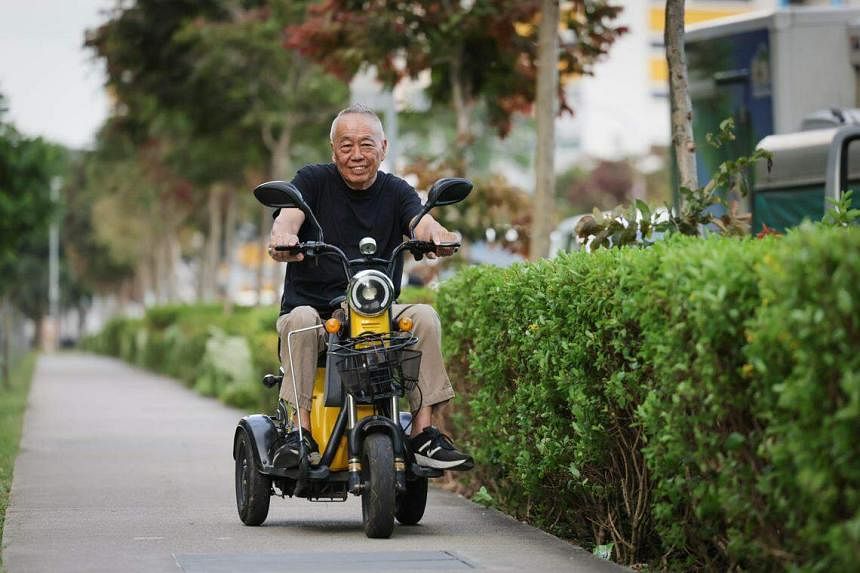
Mr Cheng Kwok Hong, a 71-year-old renovation manager, uses his mobility scooter to travel between his home in Paya Lebar and his workplace in Ubi. ST PHOTO: GIN TAY
Postgraduate student Wei Xing, 30, was diagnosed with cerebral palsy from birth and has trouble maintaining her balance while walking.
With the help of her mobility scooter, she takes the MRT almost daily to meet her friends, and travels about 18km from her home in Eunos to the Singapore University of Social Sciences in Clementi for classes twice weekly.
Ms Wei added that the proposal for medical proof discriminates against people with invisible disabilities, and could subject them to scrutiny and humiliation from strangers.
“Who would like to live with this constant scrutiny? No one wants to prove to people that they are disabled,” she said.
If the proposal is written into law, Ms Wei said she would rather walk unsteadily than use a mobility scooter as she is uncomfortable with showing proof of her disability.
Several users such as Madam Hamida Din, 50, welcomed the proposed recommendations.
Without her mobility scooter, the part-time delivery rider said she cannot run errands and complete delivery orders as she has been nursing a spine injury for the past decade.
She added: “There are many people who use PMAs inappropriately. If they can walk, they should be walking. It’s dangerous to be riding with their children and wives on board, and some of them even install fancy elements like canopy roofs.”
Retired condominium technician Adam Sng uses his mobility scooter to get to community gatherings since he cannot walk long distances. He acknowledged that many PMA riders these days move “very fast”, with “stylo milo riding techniques”.
The 66-year-old said he tries to give way to most of them, and hopes the panel’s recommendations, if they come into force, will stop these youngsters from speeding.
Safety concerns
Some pedestrians ST interviewed expressed concerns about safety.Housewife Zhou Li Jing, 52, has had near-misses with PMAs.
Recounting an incident in January, when a mobility scooter sped past her family as they were getting off a bus in Canberra Drive in Yishun, Ms Zhou said it was fortunate that her husband pulled their 16-year-old son to safety in time.
She questioned the significance of the proposed 6kmh limit, adding that mobility scooters, which are heavy, can injure others even at slow speeds.
Retired bank operations manager Lum May Foong, 59, said she supports the recommended speed limit as it would make footpaths safer for children and seniors.
Housewife Sarah Yap, 56, disagreed with the suggested mandate for medical certification, saying it would affect the livelihoods of delivery riders.
“The authorities should have some empathy for those who use PMAs to earn a living,” she said, adding that she does not fear most PMA users, many of whom would honk to alert pedestrians to their presence.
Rising demand
Many brick-and-mortar stores and online platforms offer PMAs for sale.In addition, eligible low-income seniors and people with disabilities can apply for subsidised PMAs under the Agency for Integrated Care’s seniors’ mobility and enabling fund and disability agency SG Enable’s assistive technology fund.
Retailers said most of their customers are elderly people with walking difficulties, while young people with disabilities form a smaller proportion.
They added that each PMA typically costs between $1,000 and slightly over $2,000.
No nationwide figures are available for mobility aid users or the vehicles as registration is not needed upon purchase, but retailers said demand has risen in recent years.
Mr Warren Chew, founder and managing director of retailer Falcon Mobility, said his shop has already been getting new shipments of PMAs with reduced speed limits to replace existing stock with caps of 6.4kmh to 8kmh.
“By June, I expect our entire catalogue of PMAs to be future-proofed and have their speeds capped at 6kmh,” said the 47-year-old.
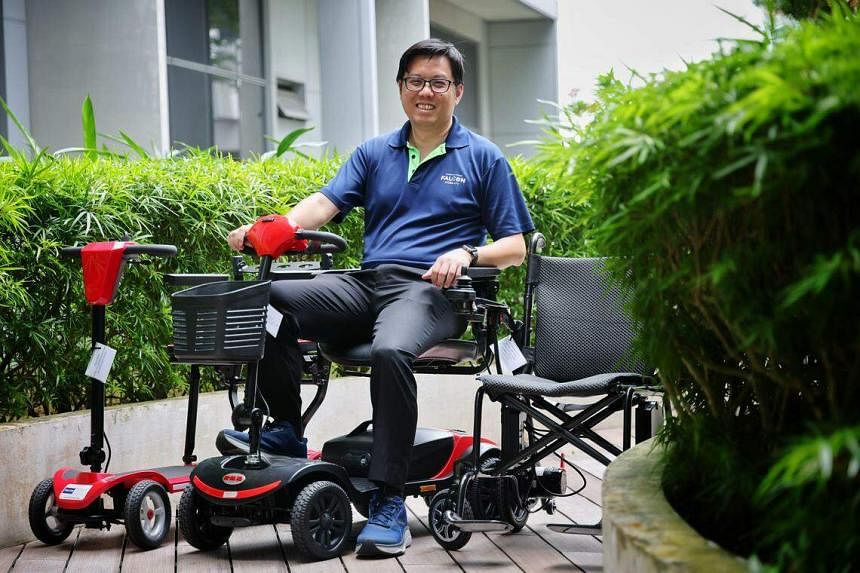
Mr Warren Chew, founder and managing director of PMA retailer Falcon Mobility, said all its mobility aids will be “future-proofed” by June 2024, with their speeds capped at 6kmh. ST PHOTO: JASON QUAH
Although Mr Chew is in favour of the speed restriction, he said medical certification may add to doctors’ workloads and make it more troublesome for users with genuine mobility problems.
Noting the complexity of medical conditions, he added that it could be difficult to determine the eligibility of users as some could have temporary conditions such as arthritis and gout.
Falcon Mobility sold 920 PMAs in 2023, up from 550 units in 2020, Mr Chew said, attributing the increase to Singapore’s rapidly ageing population.
At retailer DNR Wheels, sales and business development manager Jackson Teo said the shop sold 530 PMAs in 2023, nearly double the 270 units sold in 2020.
The 41-year-old cited the ageing population and subsidies for people who need PMAs as reasons for the increase in sales.
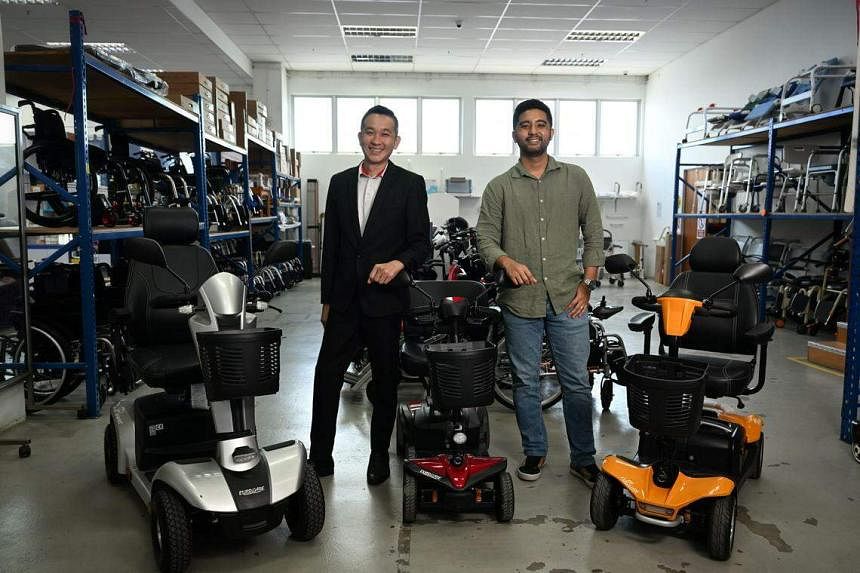
DNR Wheels sales and business development manager Jackson Teo (left) and managing director Morgan Singh. ST PHOTO: CHONG JUN LIANG
Mr Teo said only a programmer is needed to adjust the vehicle’s speed limit, adding that the community will be “much safer” with a lower speed cap.
Even if the recommendations are accepted and rolled out, Mr Chew and Mr Teo said they do not expect PMA sales to drop because of the ageing population and the Government’s moves to encourage active ageing.
There is also a sizeable number of second-hand PMA retailers on online marketplaces such as Carousell and TikTok.
Checks showed that lightly used mobility scooters up to six months old were being sold for $700 to $1,500 on Carousell.
Ms Anna Toh, 60, is selling her lightly used mobility scooter for $800 on Carousell because she was given a new one.
Having undergone two lumbar spine operations, Ms Toh said she will ask potential buyers for proof of their disability before selling her mobility scooter to them.
Wait-and-see approach
Organisations such as mall operators and hospitals said they will adjust their PMA usage guidelines accordingly if and when the Government accepts the panel’s recommendations.Mall operator Lendlease’s head of asset operations, Ms Jenny Khoo, said the company welcomed Amap’s recommendations, adding that they will help standardise how Lendlease manages the use of PMAs.
At Far East Organization, retail business group director Deborah Tan said that while there are no existing regulations on the use of PMAs in the malls it operates, the company will comply with any future rules.
Many hospitals allow the use of PMAs on their premises but will advise inpatients to leave their vehicles at home before admission. Charging of PMAs in hospital wards is not permitted.
At SGH, Mr David Lam, assistant director of biological safety, noted that since 2018, PMAs in SGH have been restricted to a lower speed limit of 5kmh, or the pace of general pedestrian traffic.
These PMAs can be used only in outpatient areas on the first level of the hospital.
Bus operator Tower Transit enforces a 10kmh speed limit for PMAs at its interchanges, in line with current footpath regulations. It does not allow these devices to enter bus parking areas.
A spokesman for Tower Transit noted that interchange staff are trained to slow speeding PMA users down.
Some general practitioners told ST they do not expect an unmanageable surge in patients trying to obtain medical certification should the proposed rules come to pass.
Dr Lim Kim Show of Life Family Clinic in Ang Mo Kio said there are enough clinics in Singapore to conduct disability checks. Typically, a gait assessment and a lower limb examination will be done, he added.
The process is quite straightforward, especially if the patients are aged above 70 or have medical conditions affecting their mobility, noted Dr Lim.
The panel had said the recommendations, if rolled out, will not have an adverse impact on genuine users as they may continue using their PMAs with existing certification from doctors, occupational therapists and SG Enable.


